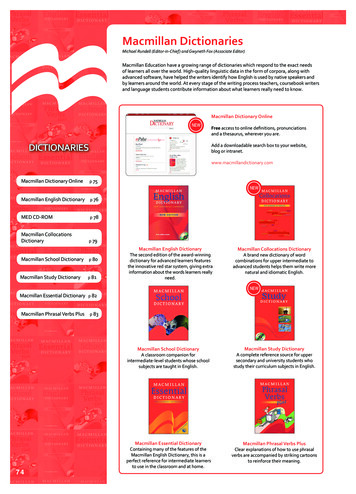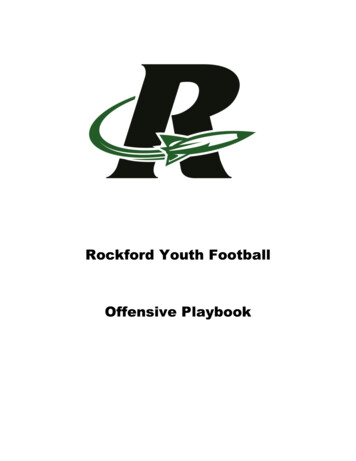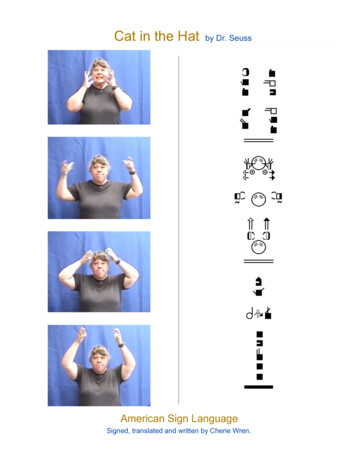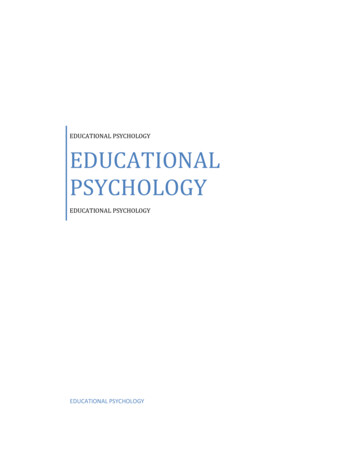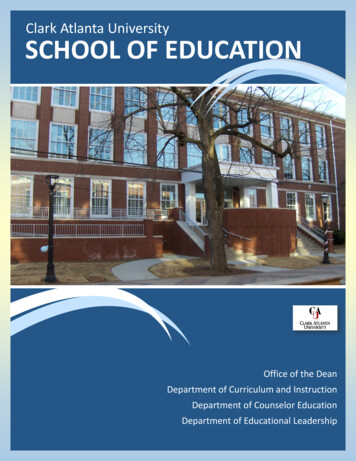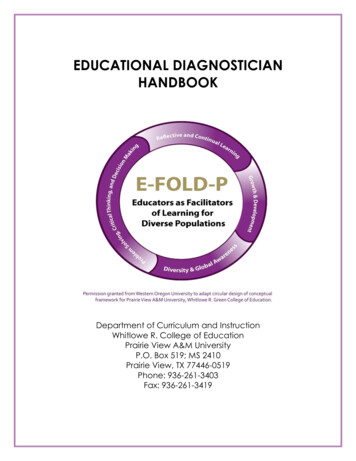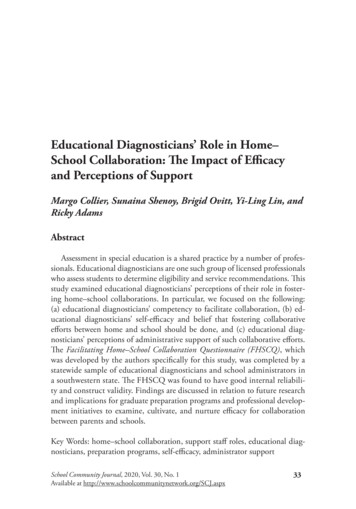
Transcription
Back to School: Supporting EducationalEnvironments Free from DiscriminationSeptember 2021U.S. Department of EducationOffice for Civil Rights
Message from the Acting Assistant Secretary for Civil RightsAs we look forward to the promise of a new academic year, amidst our nation’s ongoing effortstoemerge from the COVID-19 pandemic, the Department of Education’s Office for Civil Rights (OCR) offersthis collection of resources to assist postsecondary institutions in planning for a successful andequitable return to campus. Ensuring that these resources are easily accessible to colleges anduniversities is a top priority for OCR, particularly now, as postsecondary educators, staff, andpostsecondary leaders across the country prepare for the 2021-2022 academic year.In this collection, you will find fact sheets, Q&As, letters to educators and postsecondary leaders,and other materials about institutions’ responsibilities to provide educational environments freefrom discrimination under the federal civil rights laws enforced by OCR.These laws guarantee allstudents equal access to educational opportunities, free from discrimination based on race, color,national origin, disability, sex, and age.1OCR recognizes that students and others may experience overlapping forms of discrimination,and weencourage you to consider all of these materials together, even as the materials are organized into thefollowing three sections: Title VI: Title VI of the Civil Rights Act of 1964 prohibits discrimination on the basis ofrace,color, or national origin; Section 504 and Title II of the ADA: Section 504 of the Rehabilitation Act of 1973 and Title II ofthe Americans with Disabilities Act of 1990 prohibit discrimination on the basisof disability; and Title IX: Title IX of the Education Amendments of 1972 prohibits discrimination on thebasis ofsex.The laws and related regulations enforced by OCR that prohibit discrimination in education by all recipients offederal financial assistance are: Title VI of the Civil Rights Act of 1964, 42 U.S.C. § 2000d et seq.; 34 C.F.R. part 100(the Department of Education’s regulations implementing Title VI); Section 504 of the Rehabilitation Act of 1973,29 U.S.C. § 794; 34 C.F.R. part 104 (the Department of Education’s regulations implementing Section 504); Title IXof the Education Amendments of 1972, 20 U.S.C. § 1681 et seq.; 34 C.F.R. part 106 (the Department of Education’sregulations implementing Title IX); and the Age Discrimination Act, 42 U.S.C. § 6101 et seq.; 34.C.F.R. part 110 (theDepartment of Education’s regulations implementing the Age Discrimination Act). Title II of the Americans withDisabilities Act of 1990, 42 U.S.C. §§ 12131-12134, and the Department of Justice’s (DOJ) regulations implementingTitle II, 28 C.F.R. part 35, also prohibit discrimination in education by state and local governments, regardless ofwhether they receive federal funds. OCR is responsible for administrative enforcement of Title II with regard topublic educational institutions. For more information about Title II, see DOJ’s ADA.gov website. DOJ also enforceslaws prohibiting discrimination in educational opportunities. For more information, see DOJ’s website for theEducational Opportunities Section of DOJ’s Civil Rights Division.1i
Here are some highlights of the materials that you will find in the collection:1 – Confronting COVID-19-Related Harassment in Schools: A Resource for Families2 – Questions and Answers on Civil Rights and School Reopening in the COVID-19Environment3 – Questions and Answers on the Title IX Regulations on Sexual Harassment (July2021)4 – Confronting Anti-LGBTQI Harassment in Schools: A Resource for Students andFamilies5 – Dear Colleague Letter on RetaliationWe also encourage all educators, staff, and postsecondary leaders to review OCR’s recent report:Education in a Pandemic: The Disparate Impacts of COVID-19 on America’s Students. The reportfeatures data snapshots and 11 observations about how the pandemic has widenedexisting disparitiesin educational opportunity, particularly for students of color, students with disabilities, and LGBTQI students.OCR provides technical assistance and support to postsecondary institutions, educators, families, andstudents. You can learn more by visiting us at www.ed.gov/ocr or by contactingOCR at 800-421-3481(TDD: 800-877-8339) or at ocr@ed.gov. You can also stay up to date onOCR’s latest resources byfollowing OCR’s blog.As we look forward to the upcoming academic year, the Department of Education remains readyand available to support postsecondary institutions in meeting students’ needs duringthis criticallyimportant time.Suzanne B. GoldbergActing Assistant Secretary for Civil RightsU.S. Department of EducationSeptember 2021ii
TABLE OF CONTENTSYOUR GUIDE TO THIS RESOURCE COLLECTION . 1GUIDANCE ON TITLE VI . 2General Overview of Title VI. 2Bullying and Harassment . 2COVID-19 . 2Religious and Shared Ancestry Discrimination . 3Retaliation . 3GUIDANCE ON SECTION 504 OF THE REHABILITATION ACT AND TITLE II OF THE ADA . 4General Overview of Section 504 and Title II . 4Accessibility of Programs and Facilities . 4Auxiliary Aids and Services . 5Bullying and Harassment . 5COVID-19 . 5Equal Access . 6Retaliation . 6Specific Illnesses and Medical Conditions . 6Student Veterans with Disabilities . 7Transition to Postsecondary Education . 7GUIDANCE ON TITLE IX. 8General Overview of Title IX . 8Athletics . 9COVID-19 . 9Pregnant or Parenting Students . 9Retaliation . 10Sexual Harassment, including Sexual Violence . 10Sexual Orientation and Gender Identity . 10iii
YOUR GUIDE TO THIS RESOURCE COLLECTIONThis resource collection features a selection of OCR guidance and resources that may be usefulto postsecondary institutions throughout the 2021-2022 academic year. For each resource, youwill find a brief description and a link to full information online.Here is some additional information about this collection: Each topic area includes a combination of specific and general resources. For yourconvenience, general resources are included in each area where they are relevant. Thismeans that you will find some resources listed in multiple locations. This resource collection is also available on OCR’s website. We will update the onlineversion of this document periodically as OCR issues additional resources and guidance. Some of the resources in this collection are issued jointly by OCR and other federaloffices and agencies. Additional questions? Please note that this collection includes many OCR resources butis not comprehensive. You can find all OCR guidance resources on OCR’s website. Wealso recognize that you might have additional questions and invite you to send them tous at ocr@ed.gov. Please note that OCR guidance and other resources, including the materials in thiscollection, are designed to provide clarity on existing requirements under the law. TheseOCR resources do not have the force or effect of law and do not bind postsecondaryinstitutions or others. However, the statutes and regulatory requirements described inthe guidance are binding. On request, this publication and other publicly available Department of Educationresources are available in alternate formats, such as Braille or large print. For moreinformation, please contact the Department of Education’s Alternate Format Center at202-260-0818 or e-mail alternateformatcenter@ed.gov. The Department of Educationalso offers language assistance services for all publicly available Department ofEducation information free of charge. For more information about interpretation ortranslation services, please see this Notice to Persons with Limited English Proficiency.1
GUIDANCE ON TITLE VI:Key Guidance on Discrimination Based on Race, Color, or National OriginTitle VI of the Civil Rights Act of 1964 prohibits discrimination on the basis of race, color, ornational origin in programs and activities operated by recipients of federal funds, includingnearly all colleges, universities, and vocational rehabilitation programs. It says:No person in the United States shall, on the ground of race, color, or nationalorigin, be excluded from participation in, be denied the benefits of, or besubjected to discrimination under any program or activity receiving Federalfinancial assistance.You can find the full text of Title VI at 42 U.S.C. § 2000d.The materials below provide a general overview of Title VI and address postsecondaryinstitutions’ obligations under Title VI on the following topics: Bullying and Harassment; COVID19 response; Religion and Shared Ancestry; and Retaliation.General Overview of Title VI Starting points for learning about Title VI include:OCR's Overview, including the Title VI statute and its implementing regulationsFrequently Asked Questions on Race and National Origin DiscriminationBullying and HarassmentFact Sheet on Harassment and Bullying: This fact sheet explains institutions’responsibilities under Title VI to respond to student-on-student harassment andbullying. For more detail, see OCR’s Dear Colleague Letter on Bullying andDiscriminatory Harassment.Confronting COVID-19-Related Harassment in Schools: This resource from OCR and theDepartment of Justice’s Civil Rights Division (DOJ) includes examples of harassment andother discrimination against students during the COVID-19 pandemic, particularly AsianAmerican and Pacific Islander students, and outlines the responsibilities of institutionsto investigate and address discrimination based on race or national origin. For additionalinformation, see OCR’s Dear Educator Letter on Discrimination Against Asian Americanand Pacific Islander Students, which explains the responsibilities of institutions toaddress bullying and harassment of students based on actual or perceived race, color, ornational origin and provides links to additional resources.COVID-19Questions and Answers on Civil Rights and School Reopening in the COVID-19Environment: Section 2 of this resource answers key questions about discriminationbased on race, color, or national origin in the context of the COVID-19 pandemic,2
including how institutions must respond to harassment. This Q&A also includes links toother resources regarding COVID-19 and school reopening.Confronting COVID-19-Related Harassment in Schools: This resource from OCR and DOJincludes examples of harassment and other discrimination against students during theCOVID-19 pandemic, particularly Asian American and Pacific Islander students, andoutlines the responsibilities of institutions to investigate and address discriminationbased on race, color, or national origin.Religious and Shared Ancestry DiscriminationKnow Your Rights: Title VI and Religion: This resource explains when discriminationagainst students who are, or are perceived to be, members of a religious group fallswithin Title VI’s prohibition of discrimination based on race, color, or national origin.Fact Sheet: Combating Discrimination Against Asian American, Native Hawaiian, andPacific Islander (AANHPI) and Muslim, Arab, Sikh, and South Asian Students (MASSA):This joint resource from OCR, DOJ, and the White House Initiative on Asian Americansand Pacific Islanders provides examples of discrimination against Asian American, NativeHawaiian, Pacific Islander, Muslim, Arab, Sikh, and South Asian students that couldviolate Title VI.Fact Sheet: Combating Discrimination Against Jewish Students: This resource providesexamples of discrimination against Jewish students that could violate Title VI.RetaliationDear Colleague Letter on Retaliation: This letter explains that Title VI prohibitsretaliating against any person to interfere with their rights under Title VI or becausethey made a complaint, testified, or participated in any way in an OCR investigation orproceeding.3
GUIDANCE ON SECTION 504 OF THE REHABILITATION ACT AND TITLE II OF THE ADA:Key Guidance on Discrimination Based on DisabilityOCR enforces two federal laws that protect the rights of individuals with disabilities.Section 504 of the Rehabilitation Act of 1973 (Section 504) prohibits discrimination based ondisability in any program or activity operated by recipients of federal funds, including nearly allcolleges, universities, and vocational rehabilitation programs. Section 504 says:No otherwise qualified individual with a disability in the United States . . . shall,solely by reason of her or his disability, be excluded from the participation in, bedenied the benefits of, or be subjected to discrimination under any program oractivity receiving Federal financial assistance . . .You can find the full text of Section 504 at 29 U.S.C. § 794.Title II of the Americans with Disabilities Act of 1990 (Title II) prohibits discrimination based ondisability by public entities, regardless of whether they receive federal financial assistance. TitleII says:No qualified individual with a disability shall, by reason of such disability, beexcluded from participation in or be denied the benefits of the services,programs, or activities of a public entity, or be subjected to discrimination by anysuch entity.You can find the full text of Title II at 42 U.S.C. § 12132. The U.S. Department of Justice enforcesTitle II in all contexts, while OCR administratively enforces Title II specifically in the context ofpublic schools, including institutions of higher education, and libraries.The materials in this section describe Section 504 and Title II, provide a general overview ofboth laws, and address institutions’ obligations under these disability laws on the followingtopics: Accessibility of Programs and Facilities; Auxiliary Aids and Services; Bullying andHarassment; COVID-19 response; Equal Access; Retaliation; Specific Illnesses and MedicalConditions; Student Veterans with Disabilities; and Transition to Postsecondary Education.General Overview of Section 504 and Title II Starting points for learning about Section 504 and Title II include:OCR's Overview, including the Section 504 statute and implementing regulations andthe Title II statute and implementing regulationsFrequently Asked Questions on Disability DiscriminationAccessibility of Programs and Facilities Accessibility and usability of physical facilities: OCR’s Notice of Interpretation of Section504 of the Rehabilitation Act of 1973 explains OCR’s interpretation of Section 504 andits implementing regulations concerning the standards OCR allows recipients to use toensure accessibility and usability of physical facilities by people with disabilities. The4
Department of Justice’s Civil Rights Division (DOJ) also provides information about theAmericans with Disabilities Act and accessibility, including on the 2010 ADA Standardsfor Accessible Design.Web Accessibility: For assistance or questions about web accessibility, you can reachOCR’s Web Accessibility Team at ocr@ed.gov. Although not a Department of Educationor other federal resource, you may also find helpful information and resources from theNational Center on Accessible Educational Materials for Learning at CAST.Auxiliary Aids and ServicesAuxiliary Aids and Services for Postsecondary Students with Disabilities: HigherEducation's Responsibilities Under Section 504 and Title II of the ADA: This resourceexplains the responsibilities of postsecondary institutions to provide effective auxiliaryaids and services to students with disabilities, includes examples of the various types ofauxiliary aids and services (such as notetakers and electronic readers), and answerscommonly asked questions. For more information about electronic book readers, seeOCR’s and DOJ’s Dear Colleague Letter on Electronic Book Readers, OCR’s FrequentlyAsked Questions about the Dear Colleague Letter on Electronic Book Readers, andOCR’sQuestions and Answers about the Law, the Technology, and the PopulationAffected.Bullying and HarassmentFact Sheet on Harassment and Bullying: This fact sheet explains postsecondaryinstitutions’ responsibilities under Section 504 and Title II to respond to student-onstudent harassment and bullying. For more detail, see OCR’s Dear Colleague Letter onBullying and Discriminatory Harassment.COVID-19Questions and Answers on Civil Rights and School Reopening in the COVID-19Environment: Section 1 of this resource answers key questions about the rights ofstudents with disabilities in the context of the COVID-19 pandemic, including academicadjustments, auxiliary aids and services, and modifications for students during remoteor hybrid learning. This resource also includes links to other resources regarding COVID19 and school reopening. For information about the rights of students with disabilitiesto individualized assessment and civil rights concerns about statewide bans on universalmasking in the elementary and secondary school setting, please see this description ofOCR’s directed investigations in this area.Supporting and Protecting the Rights of Students at Risk of Self-Harm in the Era ofCOVID-19: This resource explains the Federal civil rights laws that protect students withmental health disabilities, provides crisis resources, and explains how postsecondaryinstitutions should respond to pandemic related traumas including examples ofincidents OCR investigates. For more detail, see OCR’s Dear Colleague Letter onStudents at Risk for Self-Harm or Suicide.5
Long COVID under Section 504 and IDEA: A Resource to Support Children, Students,Educators, Schools, Service Providers, and Families: This resource from OCR and theDepartment of Education’s Office of Special Education and Rehabilitative Servicesexplains the rights of students who are experiencing long-term adverse health effects ofCOVID-19, commonly referred to as long COVID. The resource provides informationabout long COVID as a disability and about schools and public agencies’ responsibilitiesto address long COVID under Section 504 and the Individuals with Disabilities EducationAct (IDEA), which applies to students in early childhood, elementary, and secondaryeducation.Equal AccessBackground and Fast Facts on Schools’ Obligation to Provide Equal Opportunity toStudents with Disabilities to Participate in Extracurricular Athletics: This resourceexplains institutions’ responsibilities under Section 504 to enable students withdisabilities to participate in extracurricular athletics, including intercollegiate, club, andintramural athletics. For more detail, including examples of how OCR analyzes whethera student has received an equal opportunity to participate, see OCR’s Dear ColleagueLetter on Students with Disabilities in Extracurricular Athletics.RetaliationDear Colleague Letter on Retaliation: This letter explains that Title II and Section 504prohibit retaliating against any person to interfere with their rights under these laws orbecause they made a complaint, testified, or participated in any way in an OCRinvestigation or proceeding.Specific Illnesses and Medical ConditionsLong COVID under Section 504 and IDEA: A Resource to Support Children, Students,Educators, Schools, Service Providers, and Families: This resource from OCR and theDepartment of Education’s Office of Special Education and Rehabilitative Servicesexplains the rights of students who are experiencing long-term adverse health effects ofCOVID-19, commonly referred to as long COVID. The resource provides informationabout long COVID as a disability and about schools and public agencies’ responsibilitiesto address long COVID under Section 504 and the Individuals with Disabilities EducationAct (IDEA), which applies to students in early childhood, elementary, and secondaryeducation.Fact Sheet on Addressing the Risk of Measles in Schools while Protecting the Civil Rightsof Students with Disabilities: This fact sheet provides information about the rights ofstudents with disabilities with respect to measles, especially those who are medicallyunable to receive vaccines due to a disability or who may be unable to attend classes forextended periods.Participation of Students with Hepatitis B in Health-Related Schools and Programs: Thisletter from OCR, DOJ, and the Department of Health and Human Services providesguidance on the responsibilities of health-related schools and programs not todiscriminate against students and applicants who have hepatitis B, including how6
institutions must analyze whether an individual with a disability would pose a directthreat to others’ health or safety. This letter also explains that a policy, practice, orprocedure regarding hepatitis B may violate Title VI if it has a disproportionate andunjustified effect on people of a particular race, color, or national origin. Student Veterans with DisabilitiesSo You Want to Go Back to School: This resource for students explains the rights ofstudent veterans with disabilities and the responsibilities of postsecondary institutionsto provide academic adjustments, auxiliary aids, and reasonable modifications topolicies and practices. For more information, see OCR’s Dear Colleague Letter onPostsecondary Students with Disabilities.Transition to Postsecondary EducationTransition of Students with Disabilities to Postsecondary Education: A Guide for HighSchool Educators: This guide, although directed to high school educators, answersfrequently asked questions about requirements for postsecondary institutions underTitle II and Section 504 concerning the transition of students with disabilities topostsecondary education, including the admissions process and the provision ofacademic adjustments and auxiliary aids and services to enrolled students.Students with Disabilities Preparing for Postsecondary Education: Know Your Rights andResponsibilities: This resource explains the rights of students with disabilities who arepreparing to attend postsecondary institutions, as well as the responsibilities ofpostsecondary institutions to provide academic adjustments to students withdisabilities, including auxiliary aids and services.7
GUIDANCE ON TITLE IX:Key Guidance on Discrimination Based on SexTitle IX of the Education Amendments of 1972 prohibits discrimination on the basis of sex in alleducation programs and activities operated by recipients of federal funds, including colleges,universities, and vocational rehabilitation programs. Title IX says, subject to certain exceptions:No person in the United States shall, on the basis of sex, be excluded fromparticipation in, be denied the benefits of, or be subjected to discriminationunder any education program or activity receiving Federal financial assistance.You can find the full text of Title IX at 20 U.S.C. § 1681.OCR enforces Title IX to ensure that students have equal access to educational opportunitiesand can go to school free from sex discrimination. This includes protection againstdiscrimination based on sexual orientation or gender identity, which the Department ofEducation recently explained in a public notice. For more on this, see the resources below.In 2020, the Department of Education amended Title IX’s implementing regulations and addedspecific requirements for how institutions must respond to allegations of sexual harassment,which includes sexual violence. These amended regulations are in effect now. OCR is currentlyundertaking a comprehensive review of these regulations, which has included holding a weeklong public hearing in June 2021. (The hearing transcript is available here.) Following thisreview, the Department of Education anticipates making additional changes to the regulations.The materials here provide a general overview of Title IX and address institutions’ obligationsunder Title IX on the following topics: Athletics; COVID-19 response; Pregnant or ParentingStudents; Retaliation; Sexual Harassment, including Sexual Violence; and Sexual Orientation andGender Identity.General Overview of Title IX Starting points for learning about Title IX include:OCR's Overview, including the Title IX statute and the 2020 amendments to itsimplementing regulations and OCR’s Notice of Interpretation of Enforcement of Title IXof the Education Amendments of 1972 With Respect to Discrimination Based on SexualOrientation and Gender Identity in Light of Bostock v. Clayton County, which clarifiesTitle IX’s coverage of discrimination based on sexual orientation and gender identity.Sex Discrimination Frequently Asked QuestionsExemptions from Title IX: This resource explains how, when, and why an institution maybe exempt from one or more of Title IX’s requirements. This includes, for example,exemptions for the membership practices of certain youth organizations (such as GirlScouts and Boy Scouts), private institutions controlled by religious organizations to theextent that application of Title IX would be inconsistent with the organization’s religioustenets, and the admissions practices of specific types of institutions, such as privateundergraduate colleges.8
AthleticsPolicy Interpretation on Title IX and Intercollegiate Athletics: This Policy Interpretationprovides comprehensive guidance on Title IX and intercollegiate athletics, includingequal opportunity in scholarships and other athletic program areas. The PolicyInterpretation also sets out a three-part test that OCR uses to assess whether aninstitution is effectively accommodating the interests and abilities of its students underTitle IX. For more information on the three-part test, see OCR’s Clarification ofIntercollegiate Athletics Policy Guidance: The Three-Part Test, Dear Colleague Letter onIntercollegiate Athletics Policy: Three-Part Test—Part Three, and Questions and Answerson Accommodating Students’ Athletic Interests and Abilities: Standards for Part Three ofthe “Three-Part Test.”Dear Colleague Letter on Athletic Activities Counted for Title IX Compliance: This letterexplains how OCR determines whether an athletic activity of an educational institutionis a sport that can be counted as part of the institution’s athletics program for thepurpose of determining compliance with Title IX, including whether the institutionprovides equal opportunity in its athletics programs.Dear Colleague Letter on Funding of Athletic Scholarships: This letter explains howOCR’s Policy Interpretation on Title IX and Intercollegiate Athletics applies to athleticscholarships and provides information on how OCR will determine whether a disparity inathletic scholarship budgets is discriminatory under Title IX.Dear Colleague Letter on Nondiscriminatory Treatment of Pregnant Students in AthleticScholarships: This letter explains institutions’ nondiscrimination responsibilities underTitle IX concerning students who are or may be pregnant or parenting, including, amongother forms of unlawful discrimination, the prohibition on terminating or reducingathletic scholarships based on a student’s pregnancy or pregnancy-related condition.COVID-19Questions and Answers on Civil Rights and School Reopening in the COVID-19Environment: Section 3 of this resource answers key questions about investigating andresolving complaints about discrimination based on sex, including sexual and genderbased harassment, in the context of the COVID-19 pandemic. This resource also includeslinks to other resources regarding COVID-19 and school reopening.Pregnant or Parenting Students Know Your Rights: Pregnant or Parenting? Title IX Protects You From Discrimination AtSchool: This resource provides information about the Title IX rights of students who arepregnant or parenting, including the right to continu
and other materials about institutions' responsibilities to provide educational environments free from discrimination under the federal civil rights laws enforced by OCR. These laws guarantee all students equal access to educational opportunities, free from discrimination based on race, color, national origin, disability, sex, and age.

